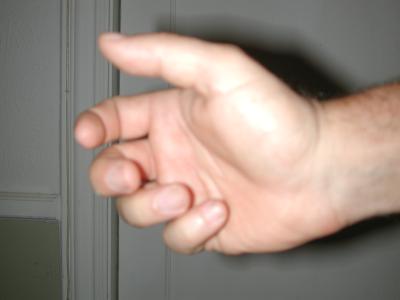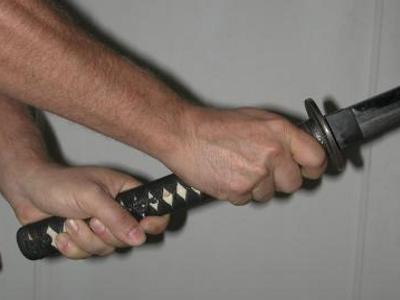Ghosts and Demons!
/ As I said yesterday, perhaps our most defining characteristic as human beings is our ability to make commitments. But such an observation brings with it the reality that we can make commitments to things which are not real, or not true. At one extreme we can make vague wishy-washy commitments, and at the other extreme we can swear an oath in blood to repeat and maintain a lie.
As I said yesterday, perhaps our most defining characteristic as human beings is our ability to make commitments. But such an observation brings with it the reality that we can make commitments to things which are not real, or not true. At one extreme we can make vague wishy-washy commitments, and at the other extreme we can swear an oath in blood to repeat and maintain a lie.Enter Yin Spirits.
A clear strong commitment can't be made when a previous commitment is in conflict with it. If the previous and now conflicting commitment is vague, irrational, or desperate, Daoists would call it a ghostly commitment. Lingering ghostly commitments tend to dilute new commitments and thus create more ghostly commitments over time.
Where do weak commitments come from in the first place? What is a ghost or a demon? To answer those two questions I'm going to have to ask another question first.
What happens when we die? From a Daoist point of view there are five possibilities; we become a god, a ghost, a demon, an immortal, or a supportive ancestor.
 At the moment of death everything which is subtle and light rises upward to join with heaven; and everything gross, heavy and thick sinks downward and becomes one with earth. The only problem is that this de-polarization can take a while to complete. The stuff that makes us what we are does not disperse immediately.
At the moment of death everything which is subtle and light rises upward to join with heaven; and everything gross, heavy and thick sinks downward and becomes one with earth. The only problem is that this de-polarization can take a while to complete. The stuff that makes us what we are does not disperse immediately.Usually when a person dies they still have a few things they wish to do, they still have a desire that is unfulfilled, or a fear that lingers. Most of these wishes quickly fade as the person dies, but not all.
A desire like, "I want to sit in my favorite chair and look out the window," would likely fade fast after death. But we've all heard the story of the unfulfilled woman who sat waiting at the window for a lover to come, only to hear a false report that something terrible has befallen her man. The woman commits suicide just at the moment her lover returns! What is left is the type of feeling that can hang around for a while after death. We don't know why this happens, but we do know that the intense feeling and lingering commitments tend to be carried forward through those who were emotionally close to the person who died.
A vow like, "I want my sons and daughters to avenge my murder," has a good chance of continuing on in some form through the living. This is true even if the sons and daughters realize that vengeance is a mistake and choose not to seek it. The fact that a parent died with such a potent unresolved will has a real effect on the children. It has the potential to interfere with their ability's to make strong clear commitments.
A behavior like a craving for a cigarette usually fades shortly after death, but in some circumstances it will be carried forward by ones descendants. This is especially true for those quirky behaviors we inherit from our families which have vague or unknown origins.
When parents experience extreme trauma it is not unusual for them to keep the details of that trauma hidden from their children but to pass on quirky or frightened behavior with out explanation. For example, the child of a Holocaust surviver who acts overly cautious about food, as if he were afraid of being poisoned, but he isn't actually afraid of that.
The Daoist definition of a ghost is a weak nagging commitment. A commitment which doesn't have enough qi to complete itself. Gods and Demons are not so different from each other. A god lower down in the Heavenly Hierarchy tends to get his start as a human who decides to keep his commitment even though he knows it will kill him.
Demon births tend to start with humans who have made very strong commitments to fantasies which spread terror and lies. After such a person dies, people who have inherited weak commitments sometimes make offerings to such a person. They collect amulets and symbols of the dead man's life and thus magnify the will of the dead over time. Hitler is a good example of a demon who lingers on through the weak commitments of the living.
It matters not at all whether you or I believe in ghosts or demons, they are real!



 their students or clients that I don't get. If you tap into a client's insecurities, or their desire for power, by convincing them that they will be freer, or happier, or stronger, or more preceptive, or even more intuitive, if only they quit eating fried chicken and do some groovy breathing exercise--who am I to get in the way? Those commitments are legitimately good for one's health. Other people are free to subordinate themselves to people and ideas.
their students or clients that I don't get. If you tap into a client's insecurities, or their desire for power, by convincing them that they will be freer, or happier, or stronger, or more preceptive, or even more intuitive, if only they quit eating fried chicken and do some groovy breathing exercise--who am I to get in the way? Those commitments are legitimately good for one's health. Other people are free to subordinate themselves to people and ideas. In an earlier post I talked about the invocation of
In an earlier post I talked about the invocation of  teaching, except to say, "sit still."
teaching, except to say, "sit still." I stopped at a gas station in the middle of nowhere on the way to the mountains last month. I checked the oil and it was pretty low so I bought a couple of quarts. I worked in a gas station when I was 14 so I know some tricks for getting a good grip, but my engine was really hot and the oil cap wouldn't budge. I went looking around in my trunk for someway to get more leverage and came up empty. I felt my manhood was being challenged. Just then a thick stocky man, about 6 inches shorter than me said, "Can I give you a hand." I'm sure I looked embarrassed but then I looked at his hands and they were clearly twice the size of mine, his fingers were as thick as cigars. "Sure, uhh...thanks" I said, and he unscrewed it. I asked where he got such huge hands and he said it was his Scottish ancestry.
I stopped at a gas station in the middle of nowhere on the way to the mountains last month. I checked the oil and it was pretty low so I bought a couple of quarts. I worked in a gas station when I was 14 so I know some tricks for getting a good grip, but my engine was really hot and the oil cap wouldn't budge. I went looking around in my trunk for someway to get more leverage and came up empty. I felt my manhood was being challenged. Just then a thick stocky man, about 6 inches shorter than me said, "Can I give you a hand." I'm sure I looked embarrassed but then I looked at his hands and they were clearly twice the size of mine, his fingers were as thick as cigars. "Sure, uhh...thanks" I said, and he unscrewed it. I asked where he got such huge hands and he said it was his Scottish ancestry.


 hand doesn't usually close.
hand doesn't usually close. is painful to hold a solid, tightly packed fist for five minutes unless your technique is good. If it hurts, it is wrong (the spirits have left the body.)
is painful to hold a solid, tightly packed fist for five minutes unless your technique is good. If it hurts, it is wrong (the spirits have left the body.) It seems that all the big sports stars are wearing compression bands or straps. Why?
It seems that all the big sports stars are wearing compression bands or straps. Why?

 Each culture has totally different standards and conceptions about what constitutes clean. Last year the New Yorker had some pictures of people living in a garbage dump in Nigeria. They were wearing bright beautiful clothing and looked cleaner than I do. Japanese are incredibly clean, I've watched men in public baths scrub their entire bodies as many as eight times before getting in the bath to soak. Yet I've seen rural places where Japanese will toss trash on the ground.
Each culture has totally different standards and conceptions about what constitutes clean. Last year the New Yorker had some pictures of people living in a garbage dump in Nigeria. They were wearing bright beautiful clothing and looked cleaner than I do. Japanese are incredibly clean, I've watched men in public baths scrub their entire bodies as many as eight times before getting in the bath to soak. Yet I've seen rural places where Japanese will toss trash on the ground. The ninth precept, yielding to others, is wuwei. The first precept probably works better in English as "Be Honest." The second precept is often the tough one for people. The flexibility part sounds cool, but the weakness part is confusing. Here is what
The ninth precept, yielding to others, is wuwei. The first precept probably works better in English as "Be Honest." The second precept is often the tough one for people. The flexibility part sounds cool, but the weakness part is confusing. Here is what 
 Today is Yom Kippur.
Today is Yom Kippur. I live and teach in San Francisco in a well sheltered park which is an old stone quarry. For the whole summer there have been three large crows hanging out in the park every morning.
I live and teach in San Francisco in a well sheltered park which is an old stone quarry. For the whole summer there have been three large crows hanging out in the park every morning.